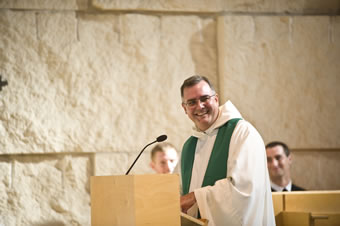Benedictines, Trappists, and Cistercians all adhere to the Rule of St. Benedict (“the Rule”) as their inspiration in the monastic way of life. Indeed, ever since St. Benedict’s time (480-547), movements of monastic renewal have frequently taken special guidance from the Rule’s profound vision of what it means to be a group of Christians living and laboring together in service of the Father’s will.
Originally written in the 6th-century for his monks in Monte Cassino, Italy, the Rule combines the traditional teaching and wisdom of ancient monasticism with St. Benedict’s own genius for the practical concerns of daily living. It is marked by moderation and a compassionate understanding of human frailty—virtues necessary for religious life in every age. Much of St. Benedict’s more detailed legislation cannot be applied directly to the conditions of modern life; for that reason, the Church now requires that each monastic congregation formulate and submit updated Constitutions that establish concrete norms for its own daily life.
And yet, although the Cistercians of Dallas are some 1500 years removed from the Rule and its historical context, it remains a fundamental source of our self-understanding and mission in the Church. In the Prologue of the Rule, St. Benedict refers to the monastery as “a school for the Lord’s service.” This definition reveals a course for the transformation of individuals within a community dedicated to the service of God. The monastery is a school and it is for the Lord’s service. At Our Lady of Dallas we strive for this ideal, and thus we hold the Rule as a foundational document for our monastic conversatio, or way of life, and as an ever bubbling spring from which we constantly draw in our conversio, or return, to God.
From the days of his novitiate, the monk at Our Lady of Dallas is instructed to profit from the wisdom contained in the Rule. Timeless themes of Christian life are beautifully expounded in its pages, such as the call of God, the pursuit of holiness, and the nature of virtues like listening (or silence), obedience, and humility. According to St. Benedict, the love of God is the root and flower of our monastic life and the end of the other virtues: “Now, therefore, after ascending all these steps of humility [Benedict lists twelve of them], the monk will quickly arrive at that perfect love of God which casts out fear. Through this love, all that he once performed out of dread, he will now begin to observe without effort, as though naturally, from habit, no longer out of fear of hell, but out of love for Christ, good habit and delight in virtue” (7:67-69).
The Rule is rightly praised for its spirit of moderation and compassionate understanding of human frailty. Benedict was acutely aware of the practical concerns of daily living, and he provides ample room for the Abbot’s discretion in determining how best to correct and encourage his monks. The monks look to the Abbot as their father, and willingly submit to his authority, so much so that they regard his instructions as the will of God for their lives. Indeed, according to the Rule, the Abbot “is believed to hold the place of Christ in the monastery” (2:2). Because of this, “The Abbot must never teach or decree or command anything that would deviate from the Lord’s instructions. On the contrary, everything he teaches and commands should, like the leaven of divine justice, permeate the minds of his disciples” (2:4-5).
Obedience to the Abbot is to be complemented by a “mutual obedience” shown by all the brothers towards each other. In both cases, the obedience rendered to a brother in love is joyfully regarded as obedience to God himself. Such a model of fraternal relationships, so wisely taught by St. Benedict, forestalls so many of the problems which arise naturally from human selfishness and vain self-exaltation. Indeed, all government and discipline outlined in the Rule aims above all to increase the measure of love and holiness in the monks, as well as in the guests that associate with them.
While the Rule considers the monastery a “school,” it does not envision a monastery with a school in the modern sense of the term. Given that we are priests and teachers in addition to monks, we extend the principles of our Rule-rooted monastic vocation to the classroom and the various areas of our priestly ministry. The Rule, however, always remains our guide as we serve the Church in these ways. For it is ultimately the love of God and neighbor that marks the essence of a life inspired by the Rule: “No one is to pursue what he judges better for himself, but instead, what he judges better for someone else. To their fellow monks they show the pure love of brothers; to God, loving fear; to their abbot, unfeigned and humble love. Let them prefer nothing whatever to Christ, and may he bring us all together to everlasting life” (72:7-11).



